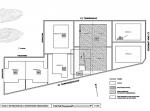Summary (English)
The excavation aimed at discovering how the stratigraphic sequence was formed and the layers that could be affected by the building of new houses. The Iberian settlement of La Loma del Escorial is placed next the mouth of La Rambla de la Carrasquilla over a small promontory of the Mar Menor. Two previous excavations in 1964 and in the 90s discovered a small highly-fortified settlement. There were quadrangular rooms and furnaces for mineral reduction. Therefore, a metallurgy plant would be probable at La Loma del Escorial. Physical remains date the settlement back to somewhere between 5th and 2nd Centuries B.C, whenCartagena was developing,By the end of that period the Barcid dynasty was ruling and the Romans people were invading the Iberian Peninsula.
La Loma del Escorial consists of a necropolis and a Roman Republican settlement called Las Mateas. On the far southwest of Los Nietos’s Old Town a plot of 2,200m2 has been examined. The area is 100m from the riverbanks of the Mar Menor and 200m from la Rambla de la Carrasquilla. The delta Lengua de Vaca has accumulated there.
The excavation goals were: – To examine the area’s geo-stratigraphic sequence. – To monitor soil removal. – To carry out geo-stratigraphic surveys. – To open several archaeological trenches.
After monitoring and characterizing the area we established that no archaeological levels are concerned by the building of the residential complex. Only a piece of agricultural land is partly concerned. Thanks to pottery remains, the plot has been dated to the Roman period. At that level, heavily-influenced by agriculture, we found two low terrace walls unconcerned by the building since they are on the garden zone or under foundations.
Below the agricultural land, Iberian remains, such as, small adobe rooms, clay extraction areas and a basin were found. A production area might have been made up both by external rooms and scattered workshop areas. It looks as if a highly complex site has been found since deteriorated and altered items are overlapped.
Therefore, we conclude that even if the residential complex is situated in an interesting area it does not concern archaeological remains in la Loma del Escorial. Studying them can help us to know about the nature of Late Iron Age settlement.
Within the most valuable area, 200 square metres belonging to Plot 3 and part of Plots 4 and 10 has been chosen.
(translation by Aroa Masa Corral)
- Antonio Javier Medina Ruiz
Director
- Antonio Javier Medina Ruiz
Team
- Mª Jesús Sánchez González
- Encarna Fortes
- Manuel López Campuzano
- Adolfo Calvo
Research Body
- Dirección General de Bienes Culturales. Consejería de Turismo y Cultura. Región de Murcia






![Download [PDF]](/excavation/skins/fasti/images/results/download_sml.png)
